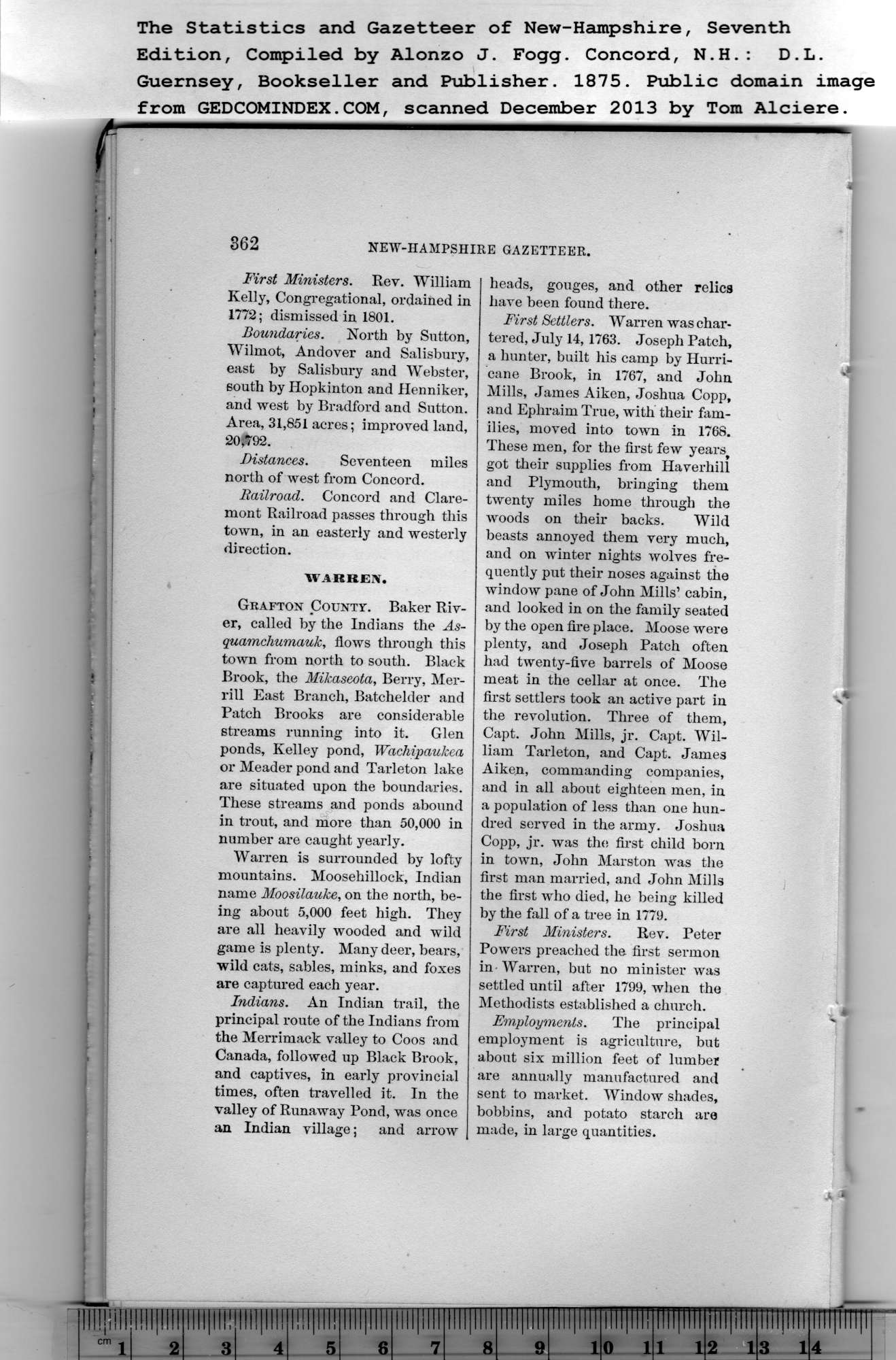|
First Ministers. Rev. William
Kelly, Congregational, ordained in
1772; dismissed in 1801.
The Statistics and Gazetteer of New-Hampshire, Seventh
Edition, Compiled by Alonzo J. Fogg. Concord, N.H.: D.L.
362 NEW-HAMPSHIRE GAZETTEER.
Boundaries. North by Sutton,
Wilmot, Andover and Salisbury,
east by Salisbury and Webster,
south by Hopkinton and Henniker,
and west by Bradford and Sutton.
Area, 31,851 acres; improved land,
20,792.
Distances. Seventeen miles
north of west from Concord.
Railroad. Concord and Clare-
mont Railroad passes through this
town, in an easterly and westerly
direction.
WARREN.
Gkafton County. Baker Riv-
er, called by the Indians the As-
quamchumauk, flows through this
town from north to south. Black
Brook, the Mikaseota, Berry, Mer-
rill East Branch, Batchelder and
Patch Brooks are considerable
streams running into it. Glen
ponds, Kelley pond, Wachipaukea
or Meader pond and Tarleton lake
are situated upon the boundaries.
These streams and ponds abound
in trout, and more than 50,000 in
number are caught yearly.
Warren is surrounded by lofty
mountains. Moosehillock, Indian
name Moosilauke, on the north, be-
ing about 5,000 feet high. They
are all heavily wooded and wild
game is plenty. Many deer, bears,
wild cats, sables, minks, and foxes
are captured each year.
Indians. An Indian trail, the
principal route of the Indians from
the Merrimack valley to Coos and
Canada, followed up Black Brook,
and captives, in early provincial
times, often travelled it. In the
valley of Runaway Pond, was once
an Indian village; and arrow
heads, gouges, and other relics
have been found there. |
First Settlers. Warren was chai--
tered, July 14, 1763. Joseph Patch,
a hunter, built his camp by Hurri-
cane Brook, in 1767, and John
Mills, James Aiken, Joshua Copp,
and Ephraim True, with their fam-
ilies, moved into town in 1768.
These men, for the first few yearst
got their supplies from Haverhill
and Plymouth, bringing them
twenty miles home through the
woods on their backs. Wild
beasts annoyed them very much,
and on winter nights wolves fre-
quently put their noses against the
window pane of John Mills’ cabin,
and looked in on the family seated
by the open fire place. Moose were
plenty, and Joseph Patch often
had twenty-five barrels of Moose
meat in the cellar at once. The
first settlers took an active part in
the revolution. Three of them,
Capt. John Mills, jr. Capt. Wil-
liam Tarleton, and Capt. James
Aiken, commanding companies,
and in all about eighteen men, in
a population of less than one hun-
dred served in the army. Joshua
Copp, jr. was the first child born
in town, John Marston was the
first man married, and John Mills
the first who died, he being killed
by the fall of a tree in 1779.
First Ministers. Rev. Peter
Powers preached the first sermon
in Warren, but no minister was
settled until after 1799, when the
Methodists established a church.
Employments. The principal
employment is agriculture, hut
about six million feet of lumber
are annually manufactured and
sent to market. Window shades,
bobbins, and potato starch are
made, in large quantities. |
